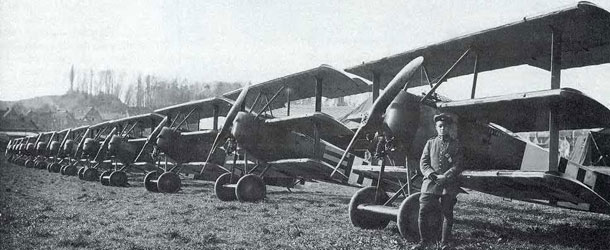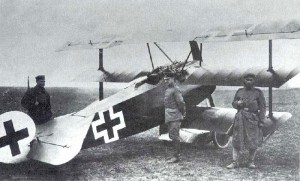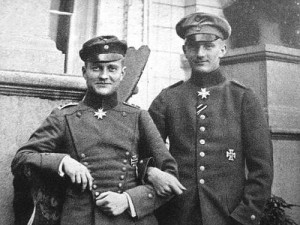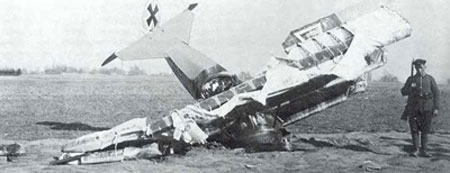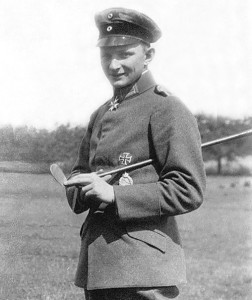In this second article about the Fokker Dr.I, know more about the pilots of the three versions of the fighter triplane featured in the WW1 Wings of Glory Airplane Packs - Manfred Von Richthofen, the legendary “Red Baron” and top ace of WW1 with 80 victories, his younger brother, Lothar von Richthofen, with 40 victories scored, and Hans Kirschstein, 27 victories.
Manfred von Richthofen
The most famous air ace of the First World War, Manfred von Richthofen was born in May 1892 in Breslau, in a Prussian noble family. With the remarkable score of 80 victories in air combats, he became the most widely known fighter pilot of all time. His success led him to be named “der Rote Kampfflieger” by the Germans, “Red Devil” and “Petit Rouge” by the French, and the “Red Baron” by the British. He has been the subject of many books, films and other media.
Manfred von Richthofen started his military career as a cavalry officer. In April 1911 he was commissioned in the 1st Regiment of Uhlans Kaiser Alexander III, and the following year he was promoted to Lieutenant. In WW1, after briefly served in the trenches, he asked to be transferred to the German Air Force, in 1915, and his request was granted.
In the flying service, he started in the Eastern front as an observer in reconnaissance missions, at the 69th Flying Squadron, from June to August 1915, and then he was sent to the Western front. There he flied with the pilot Lt. Zeumer, who encouraged him to the piloting. Together with Zeumer, Richthofen faced his first air combat, in September 1915, using a rifle against a British Farman. Few weeks later, he attacked another Farman, a French one, and downed it, but this win was not credited to him, since the aircraft fell behind Allied lines and could not be confirmed.
After he met the ace Oswald Boelcke, who impressed him for his ability, Richthofen decided to became a pilot. In October 1915, he entered training as pilot, and took his first solo flight after only 24 hours of flight training. He got his license, and in March 1916 he joined the bomber squadron Kampfgeschwader 2. On April 26 he managed to shot down a French Nieuport, but even this time the victory was not credited.
In August 1916 he met Boelcke again and was selected to join the Jasta 2. He reached his first official victory flying an Albatros D.II, on September 17th, against a British FE 2b. In one month, Richthofen had scored six kills against Allied aircrafts. On November 23rd, flying an Albatros D.II, he shot down the aircraft piloted by George Lanoe Hawker, one of the top aces of the Royal Flying Corps, after a long dogfight.
In late 1916, Richthofen painted his aircraft red and began to be known as "The Red Baron". He had 16 victories scored when he was awarded the Pour le Mérite (the Blue Max), in January 1917, and became the commander of the new Jasta 11, where he showed his qualities: methodical, he figured the odds, with mathematical precision, calculated position, angles, and fire control to kill his prey.
Richthofen led his new unit to unparalleled success, with order and discipline, requiring his fliers to study and follow his tactics. In the "Bloody April" 1917, he downed 22 British aircrafts, including four in a single day, raising his official tally to 52. By June he was the commander of the first of the new larger Jagdgeschwader (wing) formations, leading Jagdgeschwader 1, composed of Jastas 4, 6, 10 and 11 and dubbed “The Flying Circus” because of the unit's mobility (including, where appropriate, the use of tents, trains and caravans) and its brightly colored aircraft. The unit gathered Germany's top fighter pilots, among them his brother, Lothar Von Richthofen.
At the Jagdgeschwader 1, after other five victories, he was seriously wounded in the head during a combat on 6 July 1917, with a formation of F.E.2d two-seat fighters of No. 20 Squadron RFC. Instantly disoriented and temporary partial blind, he regained consciousness in time to avoid a free-falling spin and executed a rough landing in a field within friendly territory. But the injury required multiple surgeries and the wound never properly healed, causing him painful headaches.
Richthofen returned to active service on 25 July, against medical orders, and he shot down other four enemies from August 16 to September 3, and then he went on convalescent leave from 5 September to 23 October. He refused the proposal of stop combating in first line, and flying the Fokker Dr.I triplane he achieved further 19 victories, two in November 1917, and other 17 in March and April 1918.
He had scored 80 confirmed kills by 21 April 1918, when he faced his last dogfight. Over thirty planes - 15 Sopwith Camels led by Canadian Capt. Roy Brown, engaged by many Fokker and Albatros fighters - were twisting, shooting, and tearing at each other. Capt. Brown went after the Baron, firing his Lewis gun, and then Richthofen aircraft dived and crashed near Sailly-le-Sac, in a sector controlled by the Australian Imperial Force. The Aussies immediately recovered the plane and discovered inside Richthofen's body. He died following an extremely serious and fatal chest wound from a single bullet.
The Red Baron kill was officially credited to Brown, but there were controversy and contradictory hypotheses regarding the identity of the person who fired the shot that actually killed him, and it is now generally agreed that the bullet that hit Richthofen was fired by someone on the ground.
The Red Baron was 25 years old at his death. Responsible for his remains, Major Blake organized a full military funeral. Richthofen was buried in the cemetery at the village of Bertangles, on 22 April 1918. Six airmen with the rank of Captain—the same rank as Richthofen—served as pallbearers, and a guard of honor from the squadron's other ranks fired a salute. Allied squadrons stationed nearby presented memorial wreaths, one of which was inscribed with the words, "To Our Gallant and Worthy Foe". Later, his body was exhumed and reburied in the family cemetery at Wiesbaden.
Lothar von Richthofen
Born in September 1894, Lothar von Richthofen was the Red Baron’s younger brother and had a combat style completely different from him. Lothar was impulsive, aggressive and risking. He began the war as a cavalry officer with the 4th Dragoon Regiment and was awarded the Iron Cross 2nd Class for bravery in 1914.
In late 1915, he joined the German Army Air Service (Luftstreitkräfte), and was trained as a field observer. Then he was transferred to KampfStaffel 23, in the Western Front, and took part in the Verdun campaign, and later in the Battle of the Somme. In December, he won the Iron Cross 1st Class and after he began training as a pilot. He did his first solo flight on December 25th.
In early 1917, after some time at home for medical reasons, he got his pilot license on 6 March and was assigned to Jasta 11, led by his brother Manfred von Richthofen. He scored his first victory on 28 March, when he shot down a FE 2b of Royal Flying Corps. From the end of March to end of April he obtained 16 victories, and other three during the first week of May. The Germans officially credited him with shooting down the great British ace, Albert Ball, on May 7, but there is little evidence to confirm that.
His score raised to 24 wins by 13 May, when was wounded in a dogfight with a B.E.2a. The day after he was awarded Pour le Mérite, but the injuries kept him out of combat for five months. Recovered, he assumed command of Jasta 11 on 24 September 1917, and from November 9th to March 12th he scored other five victories. But on March 13th he was wounded again when engaged in combat with a Sopwith Camel. He was still in the hospital recovering from the serious head injurious when his brother died, on April 21st.
Lothar got out of the military hospital and returned to service in July. He led the Jasta 11 from 19 to 27 July and then was transferred to the command of the JG 1, formerly led by the Red Baron. From July 25th to August 12th he achieved 11 victories, before he was wounded again in action against Sopwith Camels. Promoted to Oberleutnant, he didn’t return to combat before the end of the war.
Despite the long time he spent in hospitals, Lothar had reached the remarkable number of 40 confirmed victories, and was one of the most combat efficient and prolific flying aces of the war.
He died in July 1922, when he was a commercial pilot, in a flight from Berlin to Hamburg. The engine of his plane stopped just before the airfield and crashed.
Hans Kirschstein
Born in Koblenz, on 5 August 1896, Hans Kirschstein enlisted to serve Germany in August 1914, upon the outbreak of war. He first served as a combat engineer in Poland and on the Western Front with the 3rd Pioneer Battalion. In Galicia, he contracted malaria in 1915 and went home to recover, and returned to duty in December that year. By that time, he was fascinated with the German air corps.
Two months later, he requested to be transferred and in May 1916 it was approved and he was sent to flying training. After that, he was assigned to the FA19 squadron. In this unit, he performed bombing raids in France and Flanders, including some of the earliest air attacks upon tanks. For his activities as a bomber, Kirschstein received the Iron Cross (2nd class). He continued to pilot bombers through 1917, serving at FA256 and FA3, until he asked to be transferred to a fighter squadron, in early 1918.
He passed by the fighter training and was assigned to the Jasta 6, led by Manfred von Richthofen, on March 13th. He got his first victory after only five days, when he downed a Sopwith Camel, and on March 27th he achieved other two kills in the same day. In May 1918, he was awarded the Iron Cross (1st class). By the end of that month he had scored 16 victories, and got other eight wins in five days in early June.
Kirchstein assumed the command of Jasta 6 the 10th of that month. He collected more three victories and achieved a total of 27 victories scored, being awarded the Blue Max. On July 16th, he was killed as a passenger in a Hannover CL aircraft, having earlier dropped off his own Fokker aircraft for a service at Fismes. The Hannover, piloted by Johannes Markgraf, crash-landed shortly after takeoff. A board of inquiry later concluded the crash was the result of Markgraf's inexperience on flying Hannover aircraft.
Information sources: The Aerodrome, WW1 Aviation, Ace Pilots, First World War I, The War Times Journal - The Red Fighter Pilot, Wikipedia. To see the Part 1 of this preview, click here.
